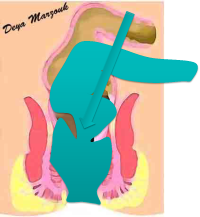
Obstruted Defaecation Web

| Anismus |
|
Anismus essentially means failure of relaxation [or paradoxic contraction] of the puborectalis muscle sling during defaecation, attempted defaecation or straining. It is also known as spastic pelvic floor syndrome or pelvic floor dyssynergia. Anismus can cause ODS & is more common in women. Coloproctologists thought they understood anismus some 20 years ago & the condition was overdiagnozed. After searching for it for over 20 years, I am fairly confident it is a rare cause. Furthermore, I have also seen it dissappear spontaneously, which explains why it was overdiagnosed at one time. It is possible to suspect anismus on digital rectal examination [DRE], but this probably highly unreliable [coversely DRE can reliably exclude anismus, if puborectalis relax on straining]. Most often the diagnosis is done using anorectal physiology testing when electromyography [EMG] of the puborectalis & external sphincter reveals the failure of relaxation or paradoxic contractions. Balloon expulsion test [BET] or more accurately failure of BET, has also been used. The condition has also been diagnosed on proctography, although this is again highly unreliable. There is poor correlation between these various tests, which makes this quite a difficult diagnosis to make with certainity. Therefore, I believe the diagnosis should be considered in the abscence of other anatomical causes of ODS & presence of clear ODS symptoms & either EMG, BET or proctographic evidence. Current treatment centres on biofeedback training, although injection of Botulinum toxins into puborectalis may be used as well. Partial division of puborectalus was used in the past & has been abandoned completely. |